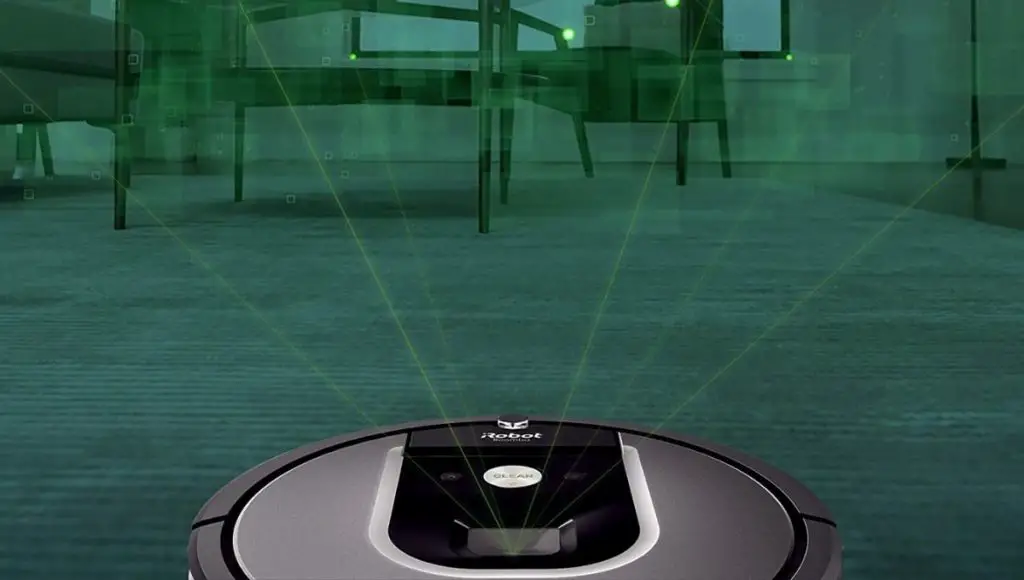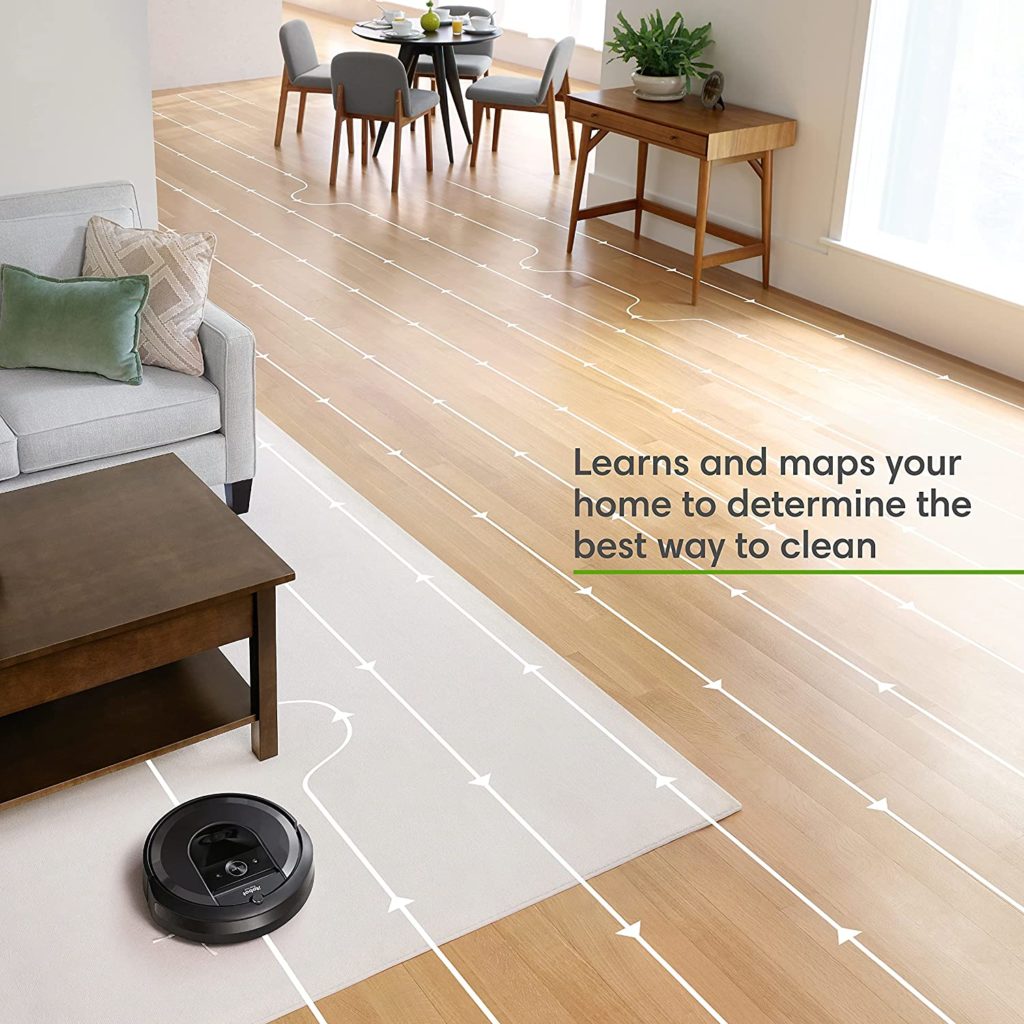The Roomba is undoubtedly a very smart gadget, and it’s always amazing to watch how it seamlessly tackles the chore of floor vacuuming, which is beyond impressive.
Even more exciting is the ability of some high-end Roomba to identify specific rooms in your home and clean them when instructed to do so. But how does the robotic vacuum know where to clean, and how does a Roomba know when its done? Why do some move in straight lines while others move randomly?
If you’ve ever pondered on these questions while wondering if you should you a robotic vacuum? Well, you’d be surprised to know that the answer is really simple: navigation technology!
Keep reading as we’ll answer these questions in detail.
How does a Roomba know where to clean?
The Roomba vacuum cleaner is obviously programmed to do the chores, but this doesn’t make it less exciting. A Roomba has inbuilt sensors that enable it to find its way around the home and make layouts (or create floor plans) of your home.
When you first introduce one of these gadgets to your home, it uses the first cleaning schedule to determine the size of your home, learn the various rooms and create maps and floor plans to allow for more efficient and seamless cleaning.
The technology is truly fascinating, and it’s seen in only newer, higher-end robots. Earlier models or low-budget Roomba vacuums usually do not feature this smart mapping technology.

How does a Roomba know when to stop cleaning?
Every Roomba vacuum cleaner, especially the newer models, has built-in mechanisms that prompt the robot to stop.
For instance, most Roomba will stop for one of the 3 reasons below:
If the bin is full: most advanced Roomba vacuum cleaners are equipped with full bin sensors that dictate when the bin is full. When the robot senses that the bin is full, it stops cleaning and returns to the auto-empty base to empty the bin. After which it goes back to continue cleaning.
If the battery is low: new generation robot vacuum cleaners also come with sensors that alert the robot when the battery is running low (typically 20% or lower). When this happens, the robot quickly navigates back to the charging station to recharge the battery. Once they get enough battery juice, they resume cleaning.
When it completes a cleaning session: this is where it gets tricky. A Roomba is able to know when it has finished cleaning your house because it has a mapping algorithm that knows the size of your house, the size of the swept area, the cleaning speed, the collisions and turns it made. All this information enables the robot to effectively detect when it has cleaned the whole floor.
Again, these smart features are often seen in high-end Roomba robot vacuum cleaners. Entry-level robot vacuum cleaners do not have any of these smart features, they can lose power mid-cleaning, and you will have to locate and rescue them. And manually empty their bin, plus they don’t have smart mapping feature.
The sensors that allow the Roomba to navigate and clean efficiently
iRobot Roomba vacuum cleaner can only clean efficiently if it’s able to seamlessly find its way around the many obstacles in a home. To make this happen, these little machines are fitted with an array of infrared sensors to help them detect the presence of an obstacle and avoid it. These sensors are usually infrared light sensors, and are found in different parts of the robot.
Collision/obstacle sensors: most robotic vacuum cleaners have object sensors on the front bumper, and when it’s approaching an obstacle (e.g. sofas, table legs, toys, chair legs, etc.), the robot will sense the obstacle and slow down. The robot sends out sensors that bounce off objects and return to the infrared receiver on the bumper. It will change direction when it bumps into an obstacle, it will often continue cleaning in a different direction.
Navigation immensely contributes to the cleaning efficiency of robotic vacuum cleaners, and collision sensors are a very important part of a Roomba’s navigation system. Typically, robotic vacuum cleaners come with a suite of sensors to enable them to navigate through the entire room more efficiently, which ultimately ensures better and faster cleaning.
In addition to collision sensors, here are other sensors that most robot vacuum have:
Cliff sensors: stairs pose a serious damage risk to robot vacuums, a devastating fall down the stairs will damage even the toughest of robot vacuums. This is why cliff sensors are absolutely critical in robot vacuums, it’s a safety requirement to ensure that a Roomba doesn’t fall to its death. Infrared beams enable the robot to detect a cliff or drop-off—usually a flight of stairs. When a Roomba detects a cliff, it moves in the opposite direction to avoid a fall.
Wall sensors: unlike other sensor types we have discussed, wall sensors don’t make the robot avoid walls, no. It in fact helps the robot identify edges and clean along for better coverage. Wall sensors also help robot vacuums with mapping capabilities to detect room edges and make more accurate floor plans.
Wheel sensors: the infrared sensor on the wheels enable the robot to detect how far it has travelled and how much area it has covered.

Mapping technology
Obstacle-detection sensors are the oldest form of navigation technology in robot vacuum cleaners. At one time, that was all they had in the way of navigation, they would wander around the home and randomly bump into things and change direction when they did.
Obstacle sensors are still a very important part of a Roomba’s navigation system since our homes are full of obstacles stopping these little machines from moving around freely. However, there is newer and more advanced room mapping that enable newer Roomba models to navigate better, clean faster and generally perform much better than the older models.
Visual navigation
High-end Roomba models combine the basic array of collision sensors with optical navigation technology. The navigation system of these Roomba models are referred to as VSLAM (Visual Simultaneous Location and Mapping). The VSLAM navigation algorithm uses a digital camera featuring an optical lens to take photos of walls, doorways, ceiling, furniture positions and various obstacles around the home.
VSLAM is also an essential feature in robot vacuums that are capable of simultaneous vacuuming and mapping, the physical sensors and optical lens ensures that it accurately identifies objects in its way while also navigating more efficiently for a faster clean. iRobot’s Roomba 900 series and the premium Roomba S9+ all feature the VSLAM navigation technology.
Some premium robot vacuums from other brands also have this feature, like the Ecovac Deebot 711, and Samsung Jetbots. Visual navigation is very efficient, but it has one major drawback. Robot vacuums that rely on optical sensors are unable to clean in the dark or dimly-lit rooms, they clean better during the day or with bright lights on.
Laser navigation
This is a more accurate type of laser-based navigation than the VSLAM technology. The LiDAR (Light Detection and Ranging) is the same technology used in some self-driving cars, and it uses a laser range-finder to measure the distance of objects from the vacuum. It uses the data it collects from its environment to build a map of each room and the entire house.
Robot vacuums with LiDAR navigation technology are able to accurately detect the size and shape of objects in their part, and with this information, they are able to differentiate furniture from a kid’s toy. They actively scan while vacuuming, and will clean with a high level of efficient cleaning and in a much shorter time.
The LiDAR navigation is seen in Neato Botvacs, high-end Roborock vacuums like the Roborock S7+, Ecovac Deebots, and many others. Robot vacuum cleaners with LiDAR navigation tend to move more confidently around the home, they vacuum, scan, and map as they go. Plus, they are able to easily find their bearing at any time.
VSLAM + LiDAR: there are a few hybrid robot vacuums that integrate these two navigation systems to achieve a greater level of efficiency. They use optical sensors and laser scanners to find their way around the home.
Final thoughts
Despite the advanced cleaning algorithm and smart technologies, no robot vacuum will accurately find its way all the time. Robot vacuums do have some flaws, and a few times you may have yours stuck under low furniture or in a loose pile of wires.
The idea is that better navigation will make these imperfect moments as rare as possible, and a robot will navigate flawlessly more often than not. Finally, the ability of a robot vacuum to clean goes beyond navigation.

About the author
Matt is the founder of the Little Robot Shop, who has spent much of the last decade hacking home cleaning with various robots and devices to make keeping his home clean as easy as possible. Not an easy task with two young children.
When not working on the Little Robot Shop website or YouTube channel, he works as technical support and product specialist for a fast-growing digital company. He does his best to get his younglings to code, which will be an essential skill in the future.
